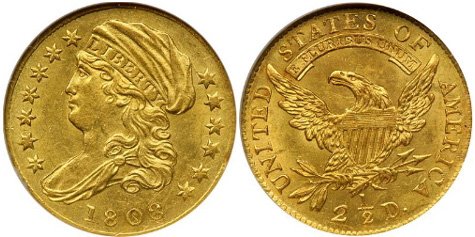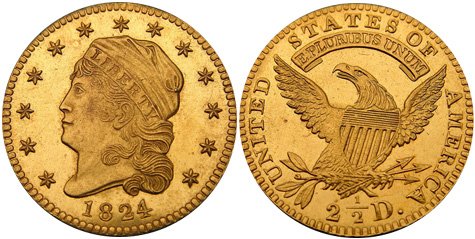Capped Bust Quarter Eagles
Source: My Coin Guides: The quarter eagles that were struck from 1808 to 1834 can be grouped into the type known as Capped Bust Quarter Eagles, although various other names have been used and the name has also sometimes been applied to the previous series. To make matters more complex, the type is also divided into three subtypes, which are sometimes considered separately. Regardless of the nomenclature, each of the types or subtypes are rare due to their extremely limited mintages.

In 1808, a new design was introduced for the quarter eagle, usually considered to be a separate type for most collectors. However, because of its close relationship to the subsequent issues, it is often discussed or grouped together amongst the broader Capped Bust Quarter Eagle series. The design was created by John Reich as part of an ongoing redesign project of all denominations. The same design would be used on other denominations as well, although in various forms. It replaced the previous design first struck in 1796 by Robert Scot, who was still employed at the Mint in 1808 and in fact superior in position to John Reich.
John Reich’s design featured a bust of Liberty, facing left. A true Phrygian cap is placed on her head, with the word LIBERTY on a band. While the overall portrayal is similar to the previous design, the specific features are noticeably different and perhaps more artistic. Thirteen stars are around the bust, which are configured seven left, six right, and the date is placed below. On the reveres, the eagle is much different from the previous design, carrying a much more natural appearance. Its wings are spread with a shield at its chest, and its claws grasp a branch and three arrows. The inscription E PLURIBUS UNUM appears on a scroll above the eagle, while UNITED STATS OF AMERICA is around. The denomination, expressed as 2 ½ D., is below.
This initial design was only struck for a single year in 1808, followed by a gap in production for the denomination until 1821. The denomination was not much needed in commerce, as it was too large. For international trade, the larger half eagles, and eagles (discontinued in 1804) were preferred and accordingly carried much higher mintages. By the time the mintage of the quarter eagle eventually resumed, John Reich had left the Mint, and his design is believed to be modified by Robert Scot, who was still at the Mint but aging. It is also possible that the new punches were made by a younger person, but this is unconfirmed.

The obverse now featured a modified head of Liberty, noticeably different from the original design by John Reich. It is related to the Matron Head large cents, but still somewhat different. The bust is smaller, with the truncation of the neck being much higher. Furthermore, the head of Liberty is much more compact, giving it an elderly appearance. The stars are positioned evenly around the portrait, no longer separated by Liberty’s head. The date is below, as it was on the previous variety. Another noticeably different feature is the addition of denticles around the rim. These were the result of more modern machinery in use at the Mint, and the first step to the introduction of a closed collar in 1829.
The above subtype, which has been named Capped Head to left in the Red Book, would be struck in 1821 and 1824 to 1827. The same major design would also be used from 1829 until 1834 with an adjusted diameter. The adjustment was minimal, from 18.5 mm to 18.2, but came together with the addition of a closed collar at the Mint. Consequently, the design was slightly altered as well, with smaller lettering and stars. The closed collar, which had been first used on dimes in 1828, resulted in a raised rim and the addition of a reeded edge upon striking the coins. This was a major improvement at the Mint, resulting in the faster production and more standardized coinage.
